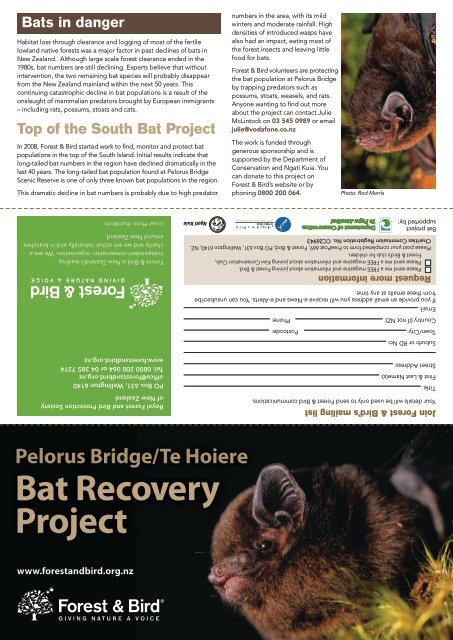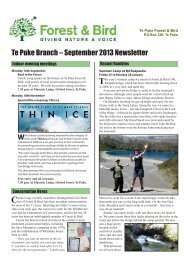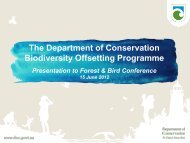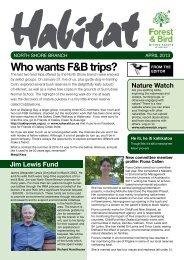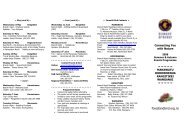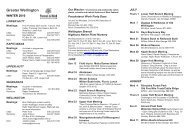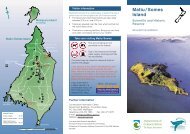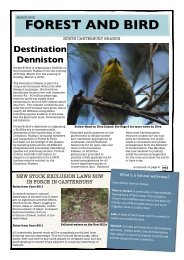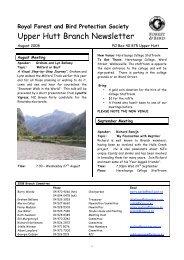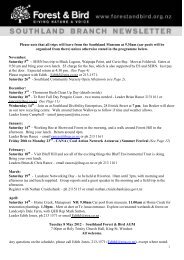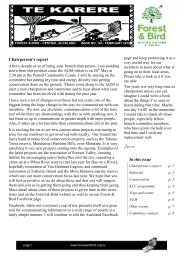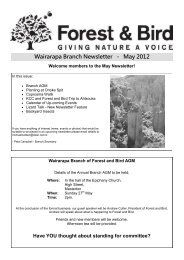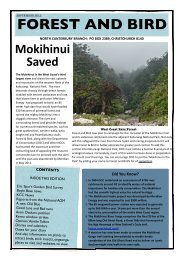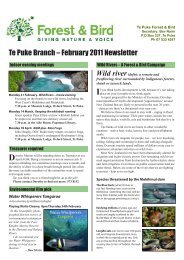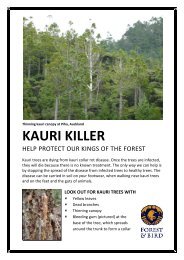Bat Brochure - Forest and Bird
Bat Brochure - Forest and Bird
Bat Brochure - Forest and Bird
Create successful ePaper yourself
Turn your PDF publications into a flip-book with our unique Google optimized e-Paper software.
<strong>Bat</strong>s in danger<br />
Habitat loss through clearance <strong>and</strong> logging of most of the fertile<br />
lowl<strong>and</strong> native forests was a major factor in past declines of bats in<br />
New Zeal<strong>and</strong>. Although large scale forest clearance ended in the<br />
1980s, bat numbers are still declining. Experts believe that without<br />
intervention, the two remaining bat species will probably disappear<br />
from the New Zeal<strong>and</strong> mainl<strong>and</strong> within the next 50 years. This<br />
continuing catastrophic decline in bat populations is a result of the<br />
onslaught of mammalian predators brought by European immigrants<br />
– including rats, possums, stoats <strong>and</strong> cats.<br />
Top of the South <strong>Bat</strong> Project<br />
In 2008, <strong>Forest</strong> & <strong>Bird</strong> started work to find, monitor <strong>and</strong> protect bat<br />
populations in the top of the South Isl<strong>and</strong>. Initial results indicate that<br />
long-tailed bat numbers in the region have declined dramatically in the<br />
last 40 years. The long-tailed bat population found at Pelorus Bridge<br />
Scenic Reserve is one of only three known bat populations in the region.<br />
This dramatic decline in bat numbers is probably due to high predator<br />
Pelorus Bridge/Te Hoiere<br />
<strong>Bat</strong> Recovery<br />
Project<br />
www.forest<strong>and</strong>bird.org.nz<br />
Cover Photo: Rod Morris<br />
<strong>Forest</strong> & <strong>Bird</strong> is New Zeal<strong>and</strong>’s leading<br />
independent conservation organisation. We are a<br />
charity <strong>and</strong> we are active nationally <strong>and</strong> in branches<br />
around New Zeal<strong>and</strong>.<br />
PO Box 631, Wellington 6140<br />
office@forest<strong>and</strong>bird.org.nz<br />
Tel: 0800 200 064 or 04 385 7374<br />
www.forest<strong>and</strong>bird.org.nz<br />
Royal <strong>Forest</strong> <strong>and</strong> <strong>Bird</strong> Protection Society<br />
of New Zeal<strong>and</strong><br />
numbers in the area, with its mild<br />
winters <strong>and</strong> moderate rainfall. High<br />
densities of introduced wasps have<br />
also had an impact, eating most of<br />
the forest insects <strong>and</strong> leaving little<br />
food for bats.<br />
<strong>Forest</strong> & <strong>Bird</strong> volunteers are protecting<br />
the bat population at Pelorus Bridge<br />
by trapping predators such as<br />
possums, stoats, weasels, <strong>and</strong> rats.<br />
Anyone wanting to find out more<br />
about the project can contact Julie<br />
McLintock on 03 545 0989 or email<br />
julie@vodafone.co.nz<br />
The work is funded through<br />
generous sponsorship <strong>and</strong> is<br />
supported by the Department of<br />
Conservation <strong>and</strong> Ngati Kuia. You<br />
can donate to this project on<br />
<strong>Forest</strong> & <strong>Bird</strong>’s website or by<br />
phoning 0800 200 064.<br />
Photo: Rod Morris<br />
<strong>Bat</strong> project<br />
supported by:<br />
Request more information<br />
Please send me a FREE magazine <strong>and</strong> information about joining <strong>Forest</strong> & <strong>Bird</strong>.<br />
Please send me a FREE magazine <strong>and</strong> information about joining Kiwi Conservation Club,<br />
<strong>Forest</strong> & <strong>Bird</strong>’s club for children.<br />
Please post your completed form to FreePost 669, <strong>Forest</strong> & <strong>Bird</strong>, PO Box 631, Wellington 6140, NZ.<br />
Charities Commission Registration No. CC26943<br />
If you provide an email address you will receive e-News <strong>and</strong> e-Alerts. You can unsubscribe<br />
from these emails at any time.<br />
Email:<br />
Country (if not NZ): Phone:<br />
Town/City: Postcode:<br />
Suburb or RD No:<br />
Street Address:<br />
First & Last Name(s):<br />
Title:<br />
Your details will be used only to send <strong>Forest</strong> & <strong>Bird</strong> communications.<br />
Join <strong>Forest</strong> & <strong>Bird</strong>’s mailing list
BATS AT PELORUS BRIDGE<br />
<strong>Bat</strong>s in New Zeal<strong>and</strong><br />
A long-tailed bat on a totara at Pelorus Reserve. Photo: DOC<br />
Although bats are now rarely seen in New Zeal<strong>and</strong>, three species of bats were widespread <strong>and</strong> abundant about<br />
700 years ago before the arrival of the first people. The greater short-tailed bat (Mystacina robusta) died out on<br />
the mainl<strong>and</strong> when Maori settlers <strong>and</strong> Pacific rats arrived <strong>and</strong> the species became extinct on its last isl<strong>and</strong> refuge in<br />
1965 after an invasion of ship rats.<br />
Lesser short-tailed bats (Mystacina tuberculata) are velvety<br />
grey-brown with large ears <strong>and</strong> a rounded tail membrane. They<br />
weigh about 15 grams, with a 280-300 mm wingspan, but are<br />
rarely seen because they fly after dark <strong>and</strong> do not usually leave<br />
their deep forest habitat. They eat fruit, pollen, nectar, <strong>and</strong> a<br />
wide range of insects, most of which they catch by furling their<br />
wings <strong>and</strong> walking through the forest floor leaf litter.<br />
Long-tailed bats (Chalinolobus tuberculatus) are chestnut<br />
brown, with small ears <strong>and</strong> a long pointed tail membrane. They<br />
weigh 8 to 12 grams <strong>and</strong> have a 240-300 mm wingspan. Flying<br />
over forest edges, lakes <strong>and</strong> slow moving rivers, they catch<br />
insects using their extended tail membrane to scoop up their<br />
prey. Travelling at up to 60 km an hour, they can cover a range<br />
of as much as 100 sq km.<br />
NZ bat facts:<br />
• Both remaining New Zeal<strong>and</strong> bat species are forest dwelling<br />
• During daytime, colonies shelter in cavities in large old trees<br />
• Females only give birth to one pup a year<br />
A home for bats at Pelorus reserve<br />
Pelorus Bridge Scenic Reserve is a popular summer<br />
destination for locals as well as New Zeal<strong>and</strong> <strong>and</strong><br />
overseas visitors. The long-tailed bat population<br />
at the reserve is the largest in the<br />
Nelson-Marlborough region <strong>and</strong> offers<br />
one of the best chances of seeing<br />
these rare bats.<br />
Photo:<br />
Jane Sedgley/DOC<br />
Two unique features of<br />
Pelorus Bridge Scenic<br />
Reserve that probably<br />
account for the bats’<br />
continued presence are<br />
a st<strong>and</strong> of mature podocarp<br />
trees <strong>and</strong> the nearby street lights.<br />
The reserve contains the largest<br />
remnant of unlogged lowl<strong>and</strong> river-flat<br />
forest in the region, a fragment of the<br />
primeval forests that covered much of the<br />
lowl<strong>and</strong>s before European settlement.<br />
Pelorus Bridge Scenic Reserve/Titiraukawa, is home<br />
to one of the last remaining populations of bats in<br />
the top of the South Isl<strong>and</strong>.<br />
A small population of long-tailed bats<br />
roost in the forest around the bridge <strong>and</strong><br />
camp site. On warm summer evenings,<br />
they can sometimes be seen after dusk,<br />
circling high in the forest canopy or flying<br />
along the Pelorus River/ Te Hoiere. When<br />
it becomes darker, they can often be<br />
glimpsed foraging for moths above the<br />
street lights.<br />
Pelorus Bridge<br />
Scenic Reserve<br />
South Isl<strong>and</strong><br />
Picton<br />
• They usually live for more than 20 years<br />
• During cold weather bats hibernate, remaining inactive for more<br />
than a week<br />
• They see well but rely on sonar to navigate in the dark.<br />
Short-tailed bat. Photo: D. Veitch/DOC<br />
Pelorus River. Photo: Brian Lloyd<br />
Two bat roosts discovered in the reserve are more than 30 metres from<br />
the ground in cavities in the trunks of large podocarps. These roosts<br />
offer some protection from predators because the trees have smooth<br />
trunks with no branches for the first 20 to 30 metres.<br />
The street lights close to Pelorus Bridge provide a convenient foraging<br />
area for the bats. They can be seen searching above the lights for moths<br />
<strong>and</strong> other flying insects almost continuously during summer nights.


